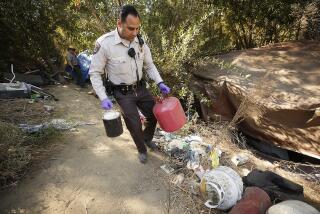Group Paints a Rosier Picture for a Valley City
The group spearheading the San Fernando Valley secession drive released a proposed budget for a breakaway city Monday, offering what it called “a more reasonable and likely scenario” that could save $200 million annually.
The plan was presented as an alternative to a final report on Valley secession unveiled Jan. 9 by the county commission studying the issue, which concluded that an independent Valley city would be financially viable.
Under that first plan by the Local Agency Formation Commission, the Valley would pay Los Angeles nearly $1 billion a year for municipal services such as police and fire protection, public works, and street sweeping. The city would employ just 36 people, with more than 8,000 Los Angeles employees providing services to the Valley under contract.
To make sure that the breakup would not financially wound either side, LAFCO recommended that the Valley city pay Los Angeles $66 million annually, a so-called alimony payment.
Valley VOTE’s analysis found that during a proposed 18-month transition period that would start Jan. 1, 2003:
* The new city would enjoy a $119.7-million surplus each year, leaving it $54.3 million after its alimony payment.
* The Valley would spend up to $700 million annually buying police, fire and other municipal services from Los Angeles.
* The fledgling city would start with 97 full-time employees in addition to its mayor and council members. By the end of the 18-month transition period, the Valley would expect to employ more than 8,000 as Los Angeles employees transfer to the new city.
* The Valley city would spend $200 million annually to pay off debts and other liabilities.
* An independent Valley city could save as much as $200 million a year by cutting overhead and tailoring services specifically to the Valley.
The new document is meant to augment LAFCO’s research. Valley VOTE and city officials are still negotiating terms of the potential split, and the commission plans to decide in late spring whether to put secession to a citywide vote in November.
“This [report] shows that the new city council and mayor will have extra money that can be used for police, paramedic and other public services,” said Richard Close, Valley VOTE’s chairman. “We’re going to be able to make the Valley a safer and better community to live in.”
But representatives of the city of Los Angeles voiced skepticism over the latest proposal.
“This is smoke and mirrors if I ever saw it,” said Lisa Gritzner, chief of staff to City Councilwoman Cindy Miscikowski. “They talk about contracting with the city of Los Angeles, but they seem to be setting their own rates. And they’re making assumptions that don’t exist in any other place in this process except their own minds.”
For example, Gritzner said, the Valley VOTE plan assumes the transfer of Van Nuys Airport--something LAFCO has not agreed to--and then credits the new city $4 million, as well as earmarking part of the city’s tobacco settlement money for the Valley.
“It seems to me they’re just creating a scenario to meet their goals,” she said.
But Dan Miller, a Valley VOTE consultant, said the plan incorporated ideas from similar-sized cities and combined some city departments to make them more efficient.
One example of such cost savings is the Office of Administrative and Research Services. The new Valley city would eliminate this Los Angeles department, saving $3 million, and its functions would be performed by the new city manager’s office, Miller said. Millions would also be shaved from the city council and mayor’s budgets.
“We basically tried to build the Valley from the bottom up,” Miller said. “We’re making our best projections.”
More to Read
Sign up for Essential California
The most important California stories and recommendations in your inbox every morning.
You may occasionally receive promotional content from the Los Angeles Times.










